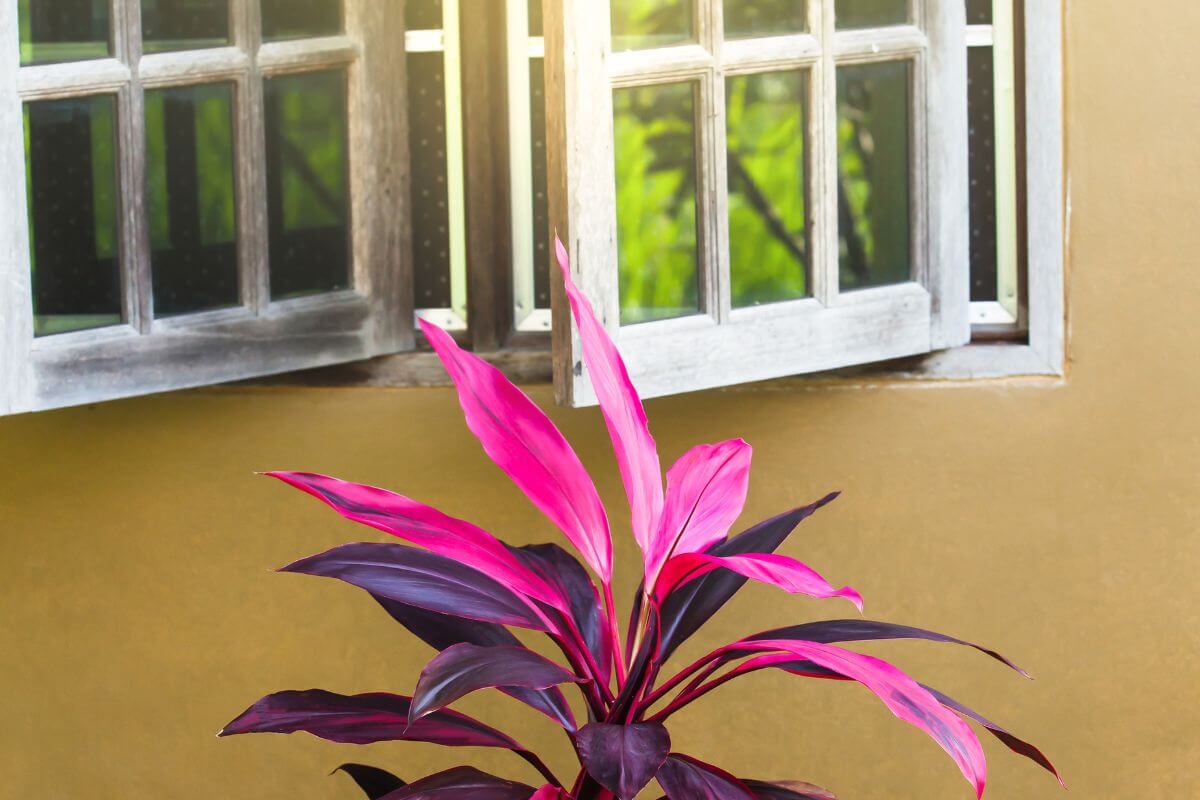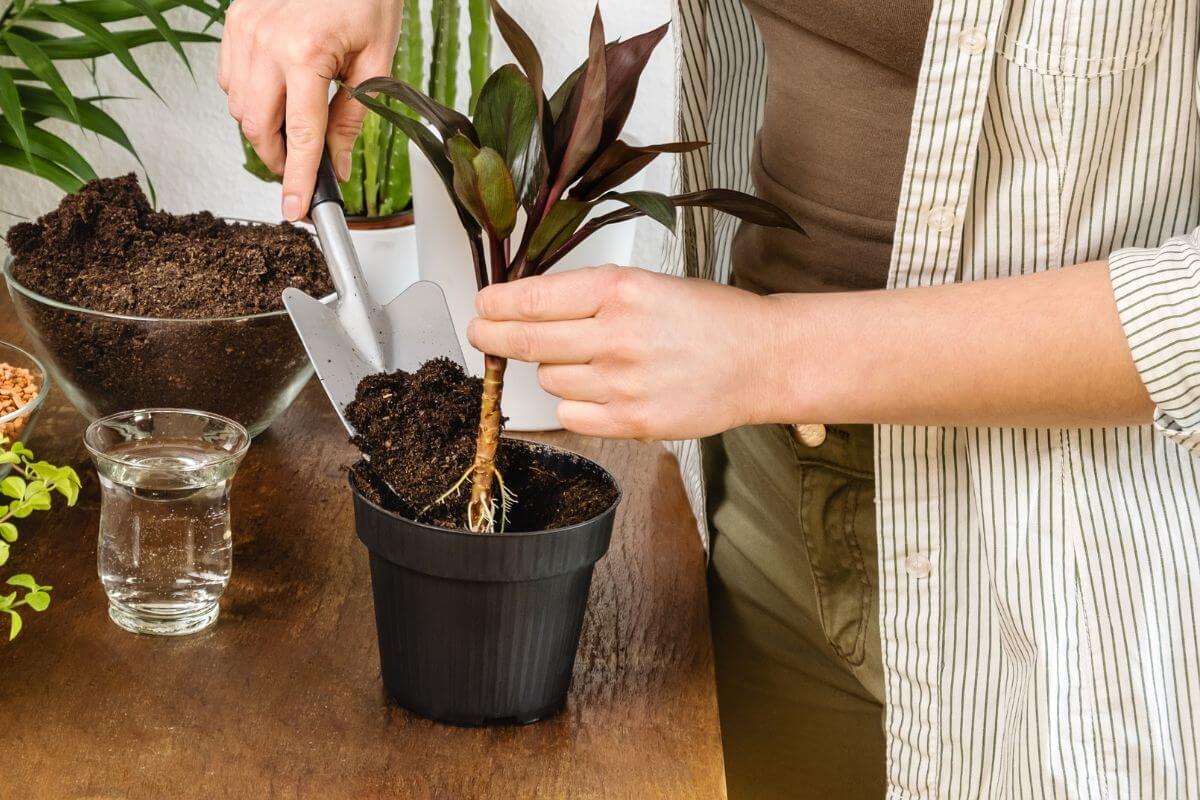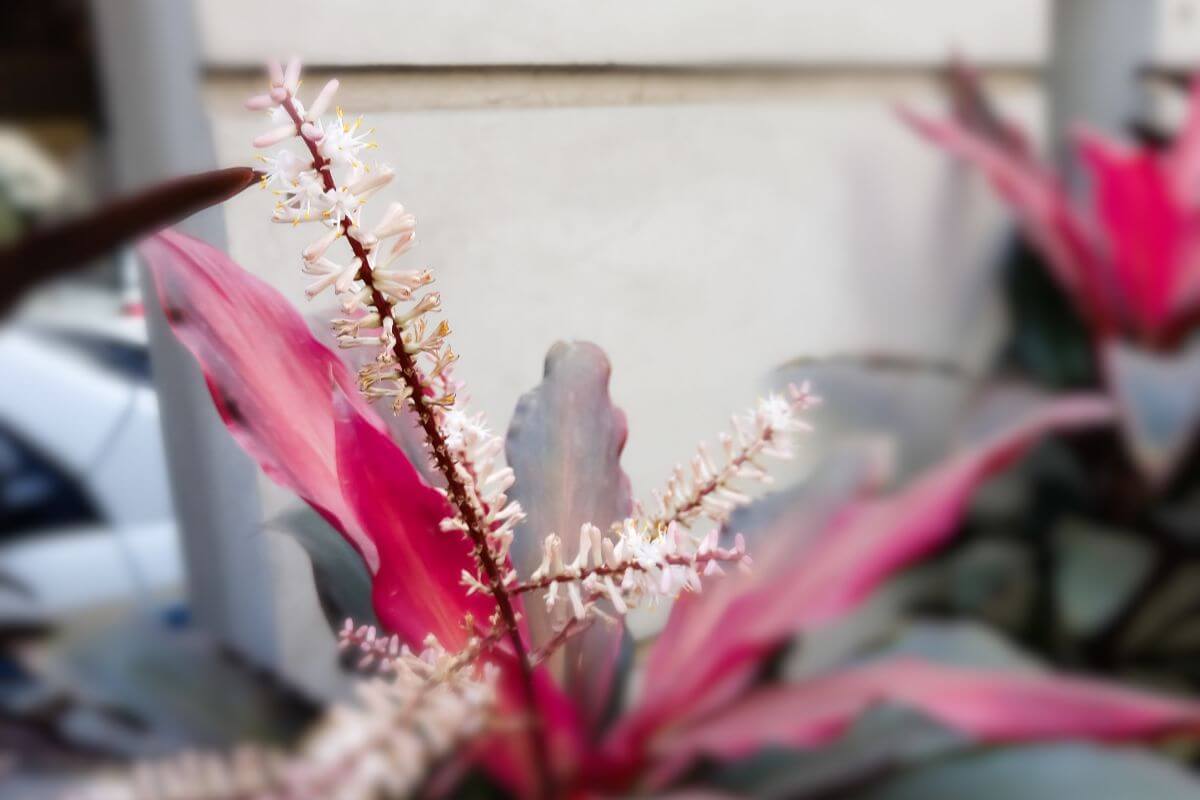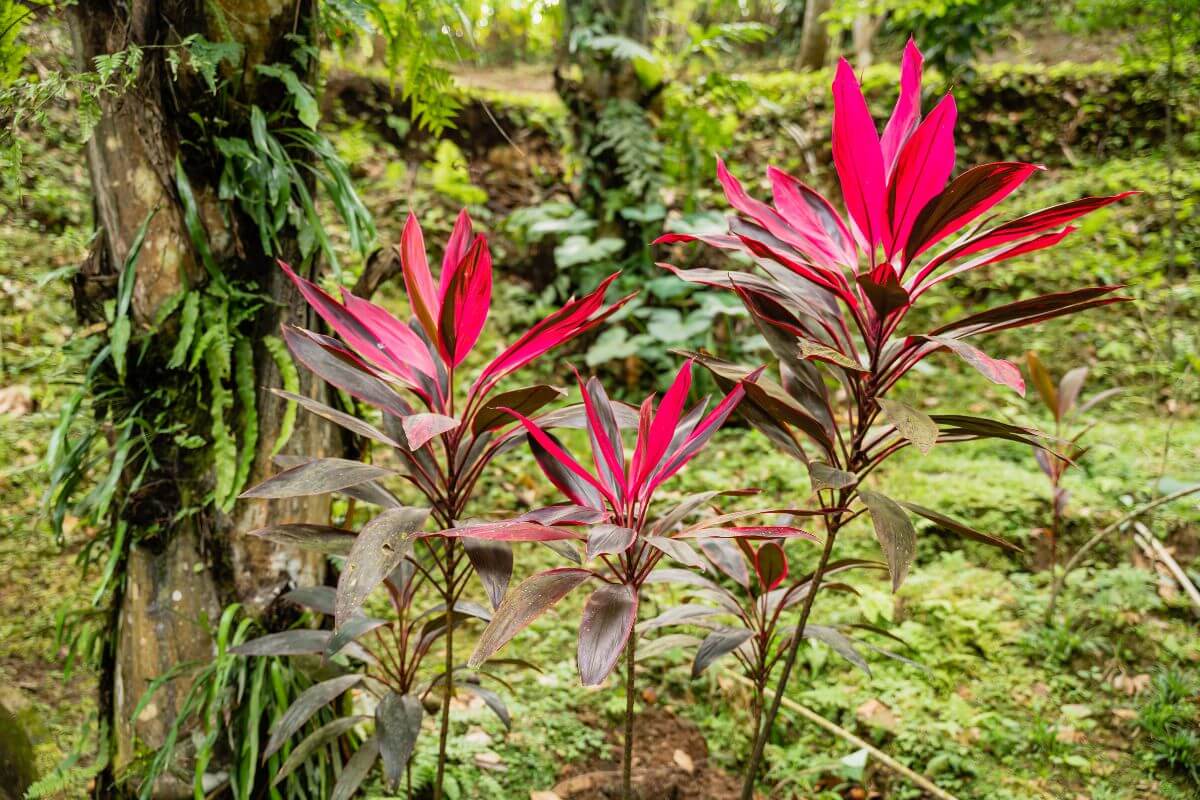The Hawaiian Ti Plant is a beautiful and popular houseplant that brightens up any room in the home or office.
- Related: Grow Guides for Houseplants
Learn how to care for the Hawaiian Ti in this in-depth guide.
Hawaiian Ti Plant Overview

The Hawaiian Ti plant or Hawaiian Good Luck plant, actually has very little to do with Hawaii, although it can be found on a few of the islands. Botanically known as the Cordyline fruticose, it is a member of the Asparagaceae family and is native to Southeast Asia.
Popular for its colorful leaves, different plant varieties come in a myriad of shades, including yellow, rose, pink, purple, maroon, and green, as a young plant.
This perennial evergreen is the size of a normal houseplant that can be positioned on tables or desks. As this plant matures, it grows to be a floor plant. Many, however, choose to cultivate them outdoors, climate permitting.
Stems are woody and cane-like while leaves resemble colorful swords that can grow to five feet in length.
These plants are quick growers and require little more than a month to grow to full size. Outdoor plants can grow to ten feet tall and four feet wide, making them an impressive presence in your yard or on your property.
Indoor Hawaiian Ti plants can be discouraged from growing this large through stem incisions.
Hawaiian Ti Plant Care Guide
Happily, this plant is not particularly demanding when it comes to temperatures unless it drops below 60° Fahrenheit.
A room that tends to remain warmer with a temperature of 65° to 85° F throughout the year will be a safe choice. Pay attention to drafts from windows, hallways, doors, or heating and air conditioning vents when positioning the Hawaiian Ti.
Growing Medium for the Hawaiian Ti Plant
The Hawaiian Ti needs well-draining soil. Loamy soil is best soil type for it, but sandy soil and most other potting mix will do as long as there are sufficient drainage holes in the plant’s container.
They prefer slightly acidic soil, so pH levels should measure between 6.0 and 6.5.
You can add some peat moss to the mix as a soil amendment.
Light for the Hawaiian Ti Plant

As a tropical plant, the Hawaiian Ti needs good bright sunlight, but indirect. Foliage colors can be sensitive to direct sunlight exposure and begin to fade.
One of the difficulties in cultivating this plant outside is finding the correct location. Indoors, this should be less of a problem.
Water and Humidity for the Hawaiian Ti Plant
Watering your Ti plant will require that the soil bed is kept evenly moist. Soggy or waterlogged soil can lead to root rot.
Allow the soil to dry out somewhat between your waterings, however, it should never dry out fully. Check for moist soil by sticking a finger into the top two inches of the soil. If it’s dry, give it a good watering.
Hawaiian Ti plants can be sensitive to chemicals contained in municipal tap water and will negatively influence foliage. Excessive amounts of chlorine and fluoride can damage your plant, so if this is the case with tap water in your area, opt for distilled water or collected rainwater.
Humidity at average home levels will be more than adequate for the Hawaiian Ti. But dry air is to be avoided as its green leaves can lose color and even be fatal to the plant if continuous over time.
If your home has higher levels of humidity, that shouldn’t be a problem, and it may even improve foliage vitality. Pebble trays and humidifiers can be used if you feel your home’s air is on the drier side.
Fertilizer for the Hawaiian Ti Plant
The Hawaiian Ti can be fed bi-weekly during its growing season with a fertilizer that is well-balanced, such as 8-8-8 or 10-10-10. But if it’s a little higher in nitrogen, it won’t hurt.
Liquid fertilizers should be diluted to half strength, so dosages are not too high.
Pruning and Repotting the Hawaiian Ti Plant

Pruning a Hawaiian Ti plant is used to help prevent the plant from becoming too tall for indoor cultivation.
Stems can be trimmed back as long as you are trimming them at least six inches above the soil bed. Damaged foliage can be pruned using a sharp sterilized pair of scissors.
It is important for this plant to have sufficient space for root growth. Repotting every other year is expected Once the plant has reached maturity, every three to four years may be sufficient.
Propagating the Hawaiian Ti Plant
Hawaiian Ti plants can be propagated using several methods, including stem cuttings, cane cuttings, division, or even air layering if the stalks of your plant are quite wide.
Cane cuttings are probably the easiest way. To propagate with cane cuttings:
- Select a healthy stem and cut it into inch-long pieces.
- Place the pieces on their sides in a container with potting soil and vermiculite or moss.
- Cover the pieces with soil.
- Place the container in a warm area that offers partial shade.
- Mist the plant cuttings several times daily.
- Within a month to six weeks, you should notice roots developing. At this point, they can be transferred to individual containers
Hawaiian Ti Plant Flowers and Foliage

Hawaiian Ti plants are beautiful ornamental plants to place around the home.
In the spring, blooms may appear in the shape of florets that are small featuring six petals in the shape of a star, and develop in shades of yellow, lavender, pink, or white.
Afterward, berries will appear that are yellow, green, or red and approximately an inch and a half in size.
Hawaiian Ti Plant Pest, Diseases, and Problems
While the Ti Plant has a reputation for resilience, it is, nonetheless, susceptible to pest infestations. Common pests include fungus gnats, spider mites, mealybugs, thrips, and scale.
Should your plant show leaf spots, stunted growth, or experience leaf drop, pests could be a likely reason.
A good water shower to remove pests and their eggs from the foliage is the place to start. Afterward, an organic insecticidal soap or neem oil should work to eliminate these undesired visitors, but use caution as they also have delicate leaves.
If leaves begin to turn brown, it can indicate overwatering, excessive sun exposure, or environmental temperatures that are too high.
If there’s too much direct sunlight, move the plant into partial shade. If it’s overwatering, reduce your watering schedule.
Yellow leaves mean that the foliage is suffering from scorching. Spotted foliage indicates that your plant has a fungal infection. You can try an organic fungicide.
Leaf drop is usually due to not watering enough. You may want to increase the frequency of watering slightly and use misting between waterings.
Hawaiian Ti Plant Toxicity and Pets

Unfortunately, for all its exotic beauty and color, the Hawaiian Ti Plant is toxic to both dogs and cats if ingested.
Typical symptoms include vomiting, hypersalivation, anorexia, depression, and dilated eye pupils in cats. If you suspect poisoning, contact your veterinarian or poison control center immediately.
Hawaiian Ti Plant Care Final Thoughts
The Hawaiian Ti Plant is an excellent houseplant for any indoor or outdoor garden. It’s easy to grow, attractive, and low maintenance. The only thing you need to remember when growing one is to keep them well watered, so they don’t dry out.
For more colorful plants and houseplants, check out these guides:
- How to Care for the China Doll Plant Guide
- How to Care for the Gloxinia Plant Guide
- How to Care for the Norfolk Island Pine Guide
Hawaiian Ti Plant Care FAQs
How do you take care of a Hawaiian Ti plant?
The Hawaiian Ti plant is easy to take care of. All you need to know is how often to water it. Water regularly during the summer months and less frequently during winter months. Keep the soil moist at all times. When the weather gets warmer, give the plant some extra light by placing it near windows with southern exposures. In cooler climates, put it outside on bright days.
Is the Ti plant an indoor plant?
The Ti plant is both an indoor and outdoor plant. Indoors will be easier to care for it as you can control the amount of bright indirect light it receives. It’s best that it doesn’t receive too much direct sunlight or the leaves will be scorched.
Can Hawaiian Ti plants take full sun?
No, the Hawaiian Ti plant cannot take full sun because it needs lots of filtered light. However, it does tolerate moderate amounts of direct sunlight.
What kind of soil should I use for my Hawaiian Ti plant?
For the Hawaiian Ti plant, most people recommend using peat moss-based potting mixes. These types of soil tend to drain better than other kinds of soil. They’re also very porous which allows air to circulate around the roots. This helps prevent root rot.
Is the Hawaiian Ti plant lucky?
The Hawaiian Ti plant is believed to bring good luck to those who own it. Some say that planting this type of plant brings prosperity while others believe that owning one means that you are destined to live a long life. Either way, having one makes life just a little sweeter!
Is the Hawaiian Ti plant poisonous to dogs?
Yes, the Hawaiian Ti plant is dangerous to pets. Even though it looks like a pretty flower, it has been known to cause severe illness in animals if chewed and eaten. Symptoms include vomiting, diarrhea, lethargy, seizures, coma, and even death. If you think your pet might have eaten something from the plant, call your vet and poison control right away.
How often should I repot a Hawaiian Ti plant?
Repot the Hawaiian Ti plant every two years while it’s young. You want to make sure that its roots aren’t cramped together. Repotting ensures proper drainage and aeration. Also, repotting gives the plant room to spread out and develop new growth. As the plant matures, you can expand it the timeframe to every 3 to 4 years.
Can You Grow Ti Plants Outside?
Yes, you can grow ti plants outdoors. In fact, they are very easy to care for and will thrive in most climates if given the proper conditions. The only thing that is different about growing them outside of indoors is that you need to be more careful with watering because it’s harder to control how much water your plant gets when it grows outside.


